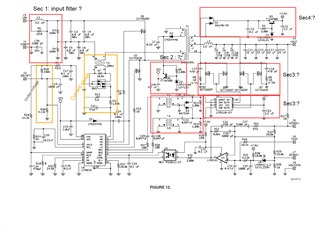Other Parts Discussed in Thread: LM5039, , LM5110
Hi guys,
I want to use the LM5039 in a half-bridge boost converter. I want to convert a12V input voltage that comes from a battery to a 24V output voltage. I'd like to use the LM5039 and the LM5039EVAL board to de-risk my application.
After looking at the LM5039EVAL schematic, they are a couple of circuits that I don't understand their purpose. Would you guys be able to help me with that please? They are the circuits highlighted in red in the below picture.
Also, the LM5039EVAL converts a [36V-75V] input voltage to a 3.3V output voltage. Would there be any ways for me to modify this board so that it converts a 12V input to a 24V output? If not, are they any other eval boards available that I could use to test my application?
Sections I can't seem to understand :
- Sec 1
- Sec 2
- Sec 3
- Sec 4
Thanks a lot for your time.


